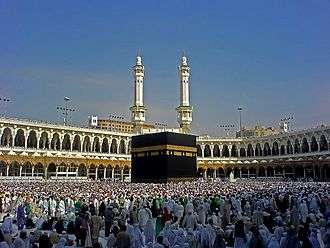Ruku
Rukūʿ (Arabic: رُكوع, [rʊˈkuːʕ]) can refer to either of two things in Islam:
- The act of belt-low bowing in standardized prayers, where the hands are rested on the knees, before straightening up to go for sujūd (full earth-low bowing).
- A paragraph of the Qur'an.

| Quran |
|---|
 |
|
In prayer, it refers to the bowing at the waist from standing (qiyām) on the completion of recitation (qiraʾat) of a portion of the Qur'an in Islamic formal prayers (salah). There is a consensus on the obligatory nature of the rukūʿ. The position of rukūʿ is established by bending over till the hands are on the knees and remaining in that position until one attains a relaxed state while glorifying God (سُبْحَانَ رَبِّيَ الْعَظِيم subḥāna rabbiya l-ʿaẓīm, "Glory be to my Lord, the Most Magnificent!") thrice or more in odd number of times.
In Al-Ghazali's book Inner Dimensions of Islamic Worship, he wrote about the rukūʿ by saying:[1]
- Bowing (rukūʿ) and prostration (sujūd) are accompanied by a renewed affirmation of the supreme greatness of Allah. In bowing you renew your submissiveness and humility, striving to refine your inner feeling through a fresh awareness of your own importance and insignificance before the might and grandeur of your Lord. To confirm this, you seek the aid of your tongue, glorifying your Lord and testifying repeatedly to His supreme majesty, both inwardly and outwardly.
- Then you rise from bowing, hopeful that He will be merciful towards you. To emphasise this hope within you, you say samiʿa -llāhu liman ḥamidah (سمع الله لمن حمده, "God heeds to those who gratefully praises Him"). Acknowledging the need to express gratitude, you immediately add, rabbanā laka l-ḥamd (ربّنا لك الحمد, "grateful praise to You, our Lord!") To show the abundance of this gratitude, you may also say malʾa s-samāwāti wa-malʾa l-ʾarḍ (ملء السماوات وملء الأرض, "as much as the heavens and the earth contain").
Qur'anic subdivision
The term rukūʿ — roughly translated to "passage", "pericope" or "stanza" — is also used to denote a group of thematically related verses in the Qur'an. Longer chapters (surah) in the Qur'an are usually divided into several rukūʿs, so that the reciters could identify when to make rukūʿ in Salat without breaking an ongoing topic in the Quranic text.
There are 558 rukūʿs in the Qur'an. In some books, 540 have been mentioned which is actually misunderstood by some people with total rukus of quran recited in Salat-ut-Taraweeh (special prayer in the Islamic month of Ramadan after the night prayer). This subdivision is not part of original revelation but adopted later-on to facilitate completion of Quran on the 27th night of Ramadhan (i.e. on Laylatul Qadr) if one ruku is recited in each rakat of taraweeh prayers (20 x 27 = 540).
See also
References
- Abu Hamid Muhammad Al-Ghazali. "Inner Dimensions of Islamic Worship Archived 2008-02-12 at the Wayback Machine" Sunnipath.com. taken from his Ihya Ulum al-Din
| Wikimedia Commons has media related to Ruku. |
